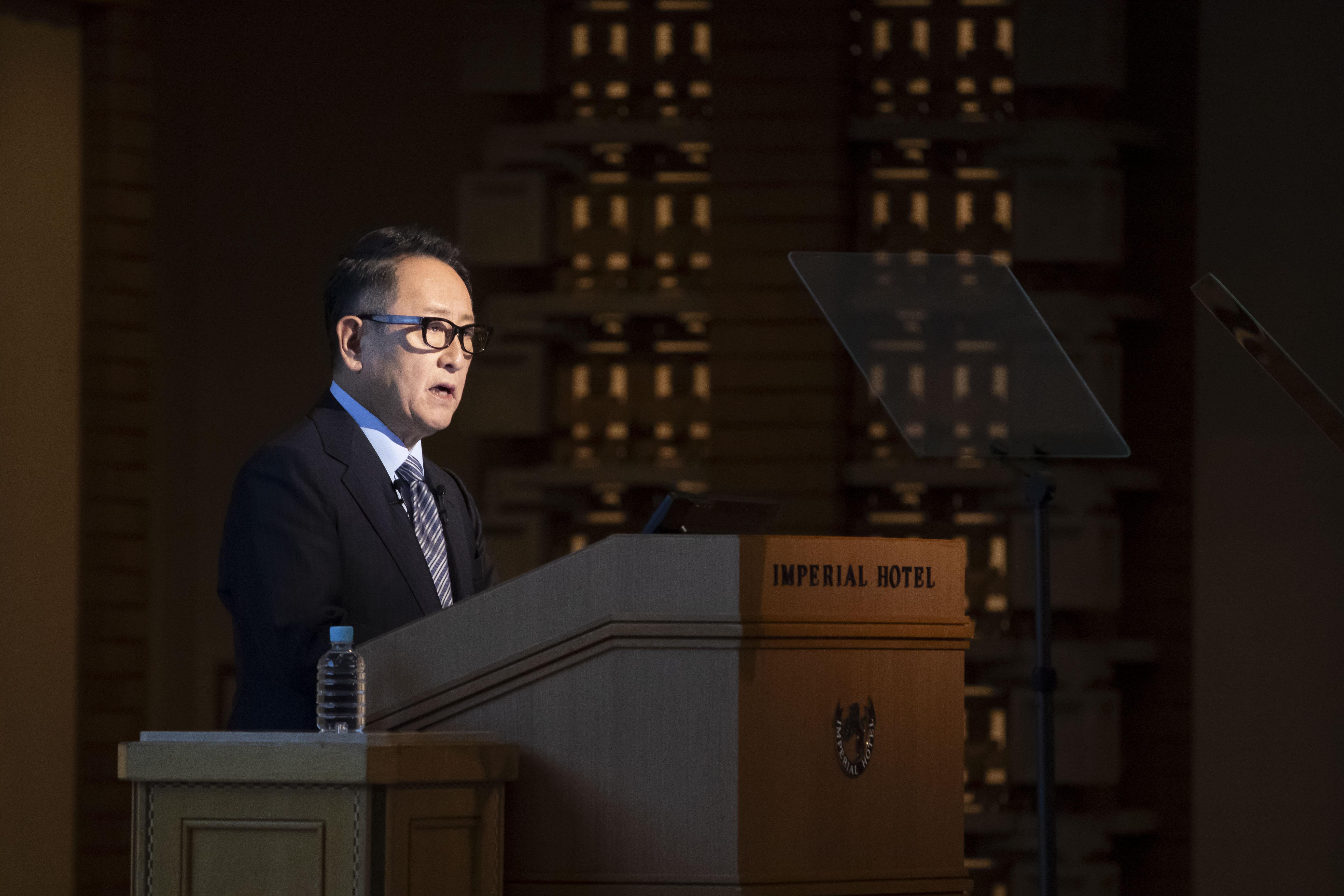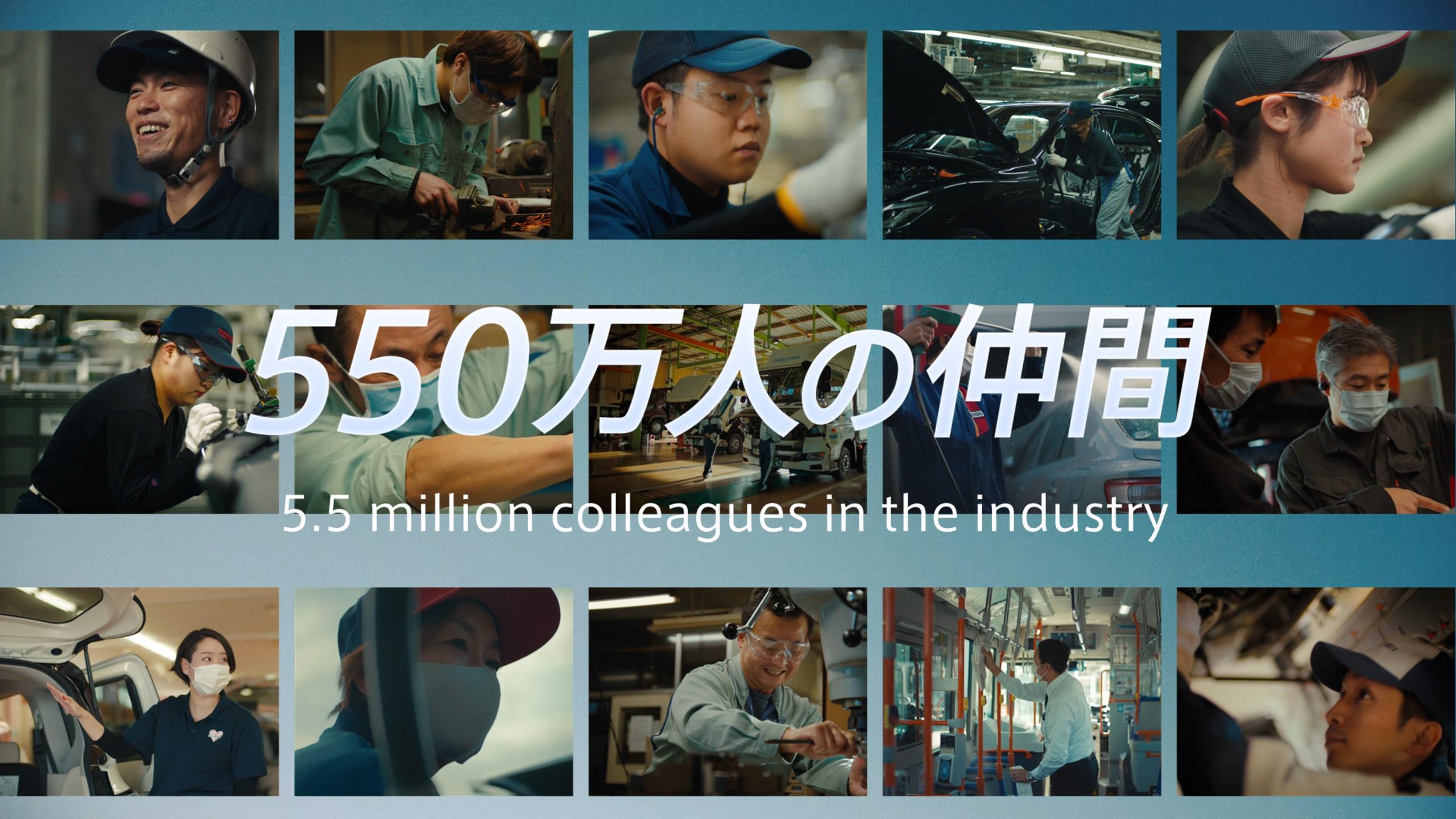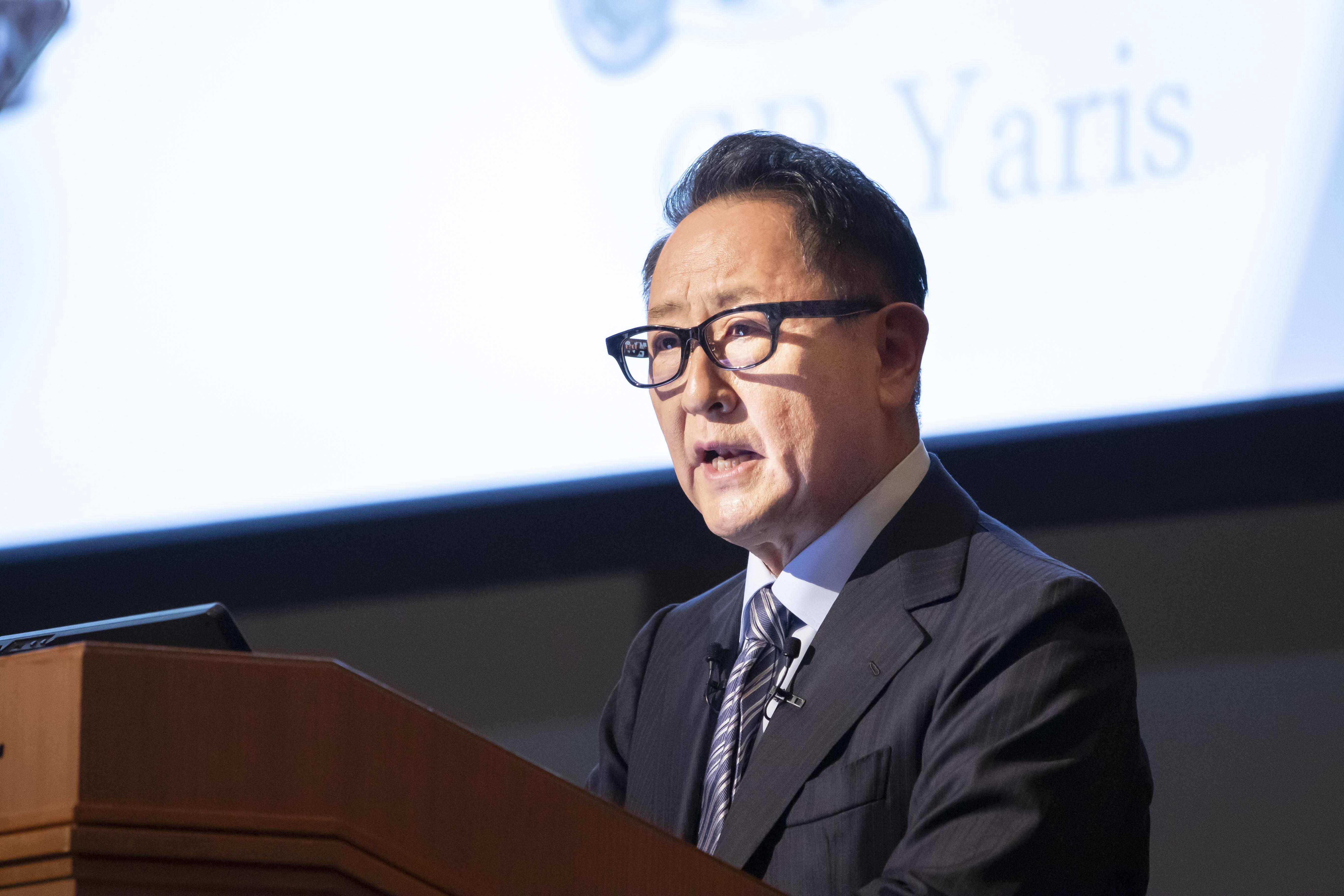
As a business leader, Akio Toyoda has approached countless decisions with a mindset rooted in the Toyota Production System. We share the lecture he delivered to a 200-strong audience of fellow corporate managers.
Fighting to restore the essence of Toyota
After the recall problem, there were many other challenges, including the Great East Japan Earthquake, floods in Thailand, and a super-strong yen.
The 14 years I served as president were a series of crises, but I believe these crises allowed me to continue in the role, making my presidency meaningful.

I think the biggest crisis was that Toyota lost sight of its core duty as a carmaker.
After I became president, someone asked me, “When did Toyota turn into a money-making company?”
An American automotive journalist remarked that “Lexus is boring—a sales channel, not a brand.”
While I was deeply dismayed, these comments also reflected something I had sensed, that Toyota, at the time, was a company focused on making money.
In pursuing increased scale, the company’s strategy was centered on “profitable cars for profitable regions”—namely, making cars for the dominant American market.
And of utmost importance within the company was the Global Master Plan, created to prioritize volumes and profits above all else.
I believe this stemmed from our oversized ego as a manufacturer that led us to believe we could sell whatever we made.
Just-in-Time means making and delivering only what is needed, in the quantity needed. In those days, however, I feel that Toyota’s culture was about making and delivering profitable cars as profitably as possible.
2. Product-centered management (TNGA, in-house company system, and master driver)
“Let’s make ever-better cars.” Spurred on by these words, my reforms at Toyota were about shifting the company’s focus from making money to making better vehicles—that is, creating a company whose operations were centered around products.
These reforms were underpinned by three pillars. The first we embarked on was TNGA.
Delivering a car’s basic capabilities—driving, turning, and stopping—at a high level requires a sophisticated platform.
Unfortunately, creating a new shared platform is far from simple.
During the company’s most trying period, when the financial crisis sent us into the red and sales stagnated, everyone gritted their teeth and gave their all to produce our most potent weapon: TNGA.
TNGA greatly transformed our products. It breathed new life into long-sellers like the Crown and Corolla as well as reviving sports cars such as the 86, Supra, and GR Yaris.

Using a shared platform enabled us to pursue a group strategy, developing products as groups rather than individual offerings to satisfy increasingly diverse customer needs.
I believe TNGA made all of this possible.
The second pillar was our in-house company system. Toyota offers a full lineup of vehicles serving every possible need for customers around the world.
During the Global Master Plan era, however, we lost the strength of a full lineup and skewed our offerings towards only products that boosted volumes and revenues.
We won’t allow such a situation to happen again. The in-house company system embodies that commitment.
Whether it is sports cars or commercial vehicles, as a full lineup company we will always have people passionate about and responsible for every genre of vehicle.
I believe that creating these conditions was the in-house company system’s true purpose.
Resisting the allure of short-term volumes and profits is not easy.
That is why I felt the need to establish people and organizations that could focus foremost on the cars that are truly necessary for Toyota and the world.
And the final element is a leader who serves as the ultimate authority.
Even if I do say so myself, I believe this is something that Toyota has, in the form of the master driver, and which other carmakers lack.
This means taking responsibility for the feel of products sent out into the world. Even if the development team has worked hard to create something, if it doesn’t feel like a Toyota or Lexus, I clearly say, “No.”
Morizo, master driver, president of Toyota.
Having worn these three hats simultaneously, I am proud to say that all the genba work I put in with colleagues over these 14 years is today embodied in Toyota’s products.
I believe this is what it means to run a company centered around products.
“Let’s make ever-better cars.” At first, no one understood what I was talking about.
Inside Toyota, people said, “You need to give us concrete specs,” while from outside, I was criticized for being unable to even set numerical targets.
At that point, if I had offered any specific examples of “ever-better cars,” people inside the company would have ceased thinking for themselves, and I believe we would not have created our current full global lineup of products.
Respecting people’s ability to think and come up with ideas—I feel this is something else that TPS has taught me.
3. Personnel reforms (executive structure & labor-management discussions)
When it comes to the people who sustain Toyota, I also poured my energies into executive reforms and employee communication.
This work took much time and effort, yet I was spurred on by the desire to ensure that the next generation would not have to face the same hardships I did.
First, on the management side, the convention at Toyota in the past was for presidents to assume office at the age of 62, but I took up the role ten years earlier, at 52.
At the time, we had 80 executives, along with 70 advisors and senior advisors, for a combined total of 150, all of them older than me.
While some of the senior staff encouraged and supported me, I’m sure that many were not pleased that precedent had been broken by appointing a younger president.
In these circumstances, I felt that to transform Toyota, I had to start from the top, and decided to reduce the number and ranks of executives.
Today, we have 14 executives with no advisors or senior advisors. The purpose is to make Toyota a company where work revolves around roles rather than titles.
Titles create hierarchies, and when this goes too far, workers lose their autonomy, merely waiting for word to come down from above.
By contrast, I felt that roles create fairness, drawing out each individual’s ability to think and act with initiative.
That is why I needed to change the company to operate based on roles rather than titles. Having struggled against the preconceptions that came with my “founding family member” title, I saw this as my personal mission.
Next, I would like to talk about communication with employees. Please watch the following video.
The company seeks happiness for its employees, and employees desire growth for the company. This shared foundation has been upheld by Toyota’s workers and management alike. I regard employees as family and our labor-management discussions as conversations between family members.
It is the father’s role to reprimand children when they start to go down the wrong path. With this mindset, over my 14 years, I have sought to engage face-to-face with each and every employee.
In this, there was absolutely no falsehood. I rejoiced, laughed, cried, and scolded in earnest.
As a result, I feel that Toyota’s labor-management dialogues have changed dramatically.
Instead of merely advocating our own interests, they have become a platform for considering those of our 5.5 million peers working in Japan’s auto industry.

Monozukuri is about developing people. I believe this, too, is a tenet of TPS.
No going back
Whenever I faced a crisis or problem, I always went to the genba. Based on the facts and realities that I saw, heard, and experienced there for myself, I would decide the path that Toyota should take.
I continued to push for making ever-better cars. I believe this reflects the essence of TPS: the drive for continuous improvement.
To achieve this, we must develop people who embody Toyota’s philosophy, skills, and conduct.
Toyota used to be a highly bureaucratic company, where authority rested with a small group of people who held certain titles, and decisions were made on head office desks, not in the genba.
Ever since joining the company, I couldn’t help but question whether Toyota had always been this way. I think it stemmed from the corporate culture that had taken root in the vast organization.
“Let’s make ever-better cars.”
“Let’s aim to be best-in-town.”
“Let's work for someone other than ourselves.”
At first, no one took my words and actions seriously, yet they resonated most with people in the genba.
Individual genba workers came to think and act on their own initiative. I believe it was only when people changed that our products and Toyota were transformed.

In today’s Toyota, authority rests in a genba that thinks and acts for itself. Above all else, this is what I wanted to restore.
If we’re not careful, however, this genba-driven management style may swiftly revert to one where the central headquarters holds sway.
I constantly fear that, after spending so much time and effort transforming Toyota, the company may relapse into its bureaucratic past.
By the time everyone senses this, it will be too late.
I will never let Toyota return to its past bureaucratic ways. That is why I must continue to fight.
Just as in TPS, improvement is never-ending, so too is the fight to restore Toyota’s essence. I would like to end my talk on that note. Thank you for your kind attention.

